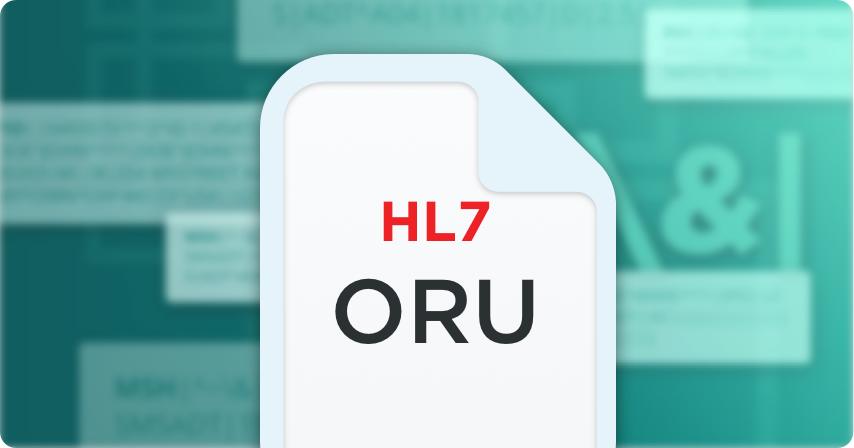
HL7 ORU
Observation Result
An HL7 Observation Result (ORU) message contains information about a patient’s clinical observations and is used in response to an order generated in a clinical system (HL7 ORM message).
ORU (Observation Result)
ORU messages are most commonly used within the context of EKG studies, laboratory results, imaging studies, and medical interpretations. They have also been used to communicate order and results information for the purpose of clinical trials (e.g. drug development). It is important to note that ORU messages do not natively contain images, but use a combination of text, codes and numbers to communicate results.

The ORU message has only two different message types:
- ORU^R01 - Unsolicited transmission of an observation result.
This message is generated when results from the receiving (results) system (LIS, RIS, EKG) need to be communicated to the sending (ordering) system (HIS, EMR) - ORU^W01 - Waveform result, unsolicited transmission of requested information.
This message type transmits waveform data (e.g. produced from electrocardiograms) produced by an ordered test or multiple observations.
Sample ORU Message
Below is an example of an HL7 version 2.4 ORU^R01 message:
MSH|^~\&|MESA_RPT_MGR|EAST_RADIOLOGY|iFW|XYZ|||ORU^R01|MESA3b|P|2.4||||||||
PID|||CR3^^^ADT1||CRTHREE^PAUL|||||||||||||PatientAcct||||||||||||
PV1||1|CE||||12345^SMITH^BARON^H|||||||||||
OBR|||||||20010501141500.0000||||||||||||||||||F||||||||||||||||||
OBX|1|HD|SR Instance UID||1.113654.1.2001.30.2.1||||||F||||||
OBX|2|TX|SR Text||Radiology Report History Cough Findings PA evaluation of the chest demonstrates the lungs to be expanded and clear. Conclusions Normal PA chest x-ray.||||||F||||||
CTI|study1|^1|^10_EP1| Segment | Description |
|---|---|
| MSH | Message Header. This segment is a mandatory part of an ORU message, and contains information about the message sender and receiver, the date and time that the message was created. This segment is required. |
| PID | Patient Identification. An ORU message is a patient-specific message type, and must be linked to a particular patient. Therefore, patient information such as the patient identifier, name, date of birth, etc. must be included in an ORU. This segment is required. |
| PV1 | Patient Visit. This segment contains information about patient visit details such as servicing facility, attending doctor, and visit ID. This segment is required. |
| OBR | Observation Request. This segment identifies the observation that was ordered in order to generate the ORU message. This segment is required. |
| [{OBX}] | Observation Segment. Here is where information about the observation results is held. An OBX segment is used to communicate a single observation, so multiple observations would require this segment to repeat. This segment is optional and can be repeating. |
| [{CTI}] | Clinical Trial Identification. This is an optional segment and is only used if the results need to be linked to a clinical trial. Information such as the trial ID, study phase, and time point is included here. This segment is optional and can be repeating. |
| [ ] = optional, { } = repeating | |
For more information on implementing various HL7 message types, please refer to the HL7 Messaging Standard Implementation Guides corresponding to your required version.
Working With ORU Messages
Are you working with HL7 ORU messages? In order to successfully process these messages, it's important to understand the specific format that the sending and receiving facilities are expecting the ORU messages to adhere to. Discrepancies can occur due to the version of HL7, system input error, or even simply human error when the messages were created.
How does Iguana ensure that ORU messages are properly formatted to ensure system compatibility?
Iguana is a data integration platform that allows you to easily customize the format, structure, and field values of your HL7 messages so that they are normalized, ensuring compatibility with any system you might need to interact with.
Get a demo: See Iguana in action
Ensure deliverability by customizing HL7 ORU messages to system specifications.
Other HL7 Message Types
- HL7 ADT (Admit, Discharge and Transfer)
- HL7 ORM (Order Entry)
- HL7 ORU (Observation Result)
- HL7 MDM (Medical Document Management)
- HL7 DFT (Detailed Financial Transactions)
- HL7 BAR (Billing Account Record)
- HL7 SIU (Scheduling Information Unsolicited)
- HL7 RDS (Pharmacy/treatment Dispense)
- HL7 RDE (Pharmacy/Treatment Encoded Order)
- HL7 ACK (Acknowledgement Message)